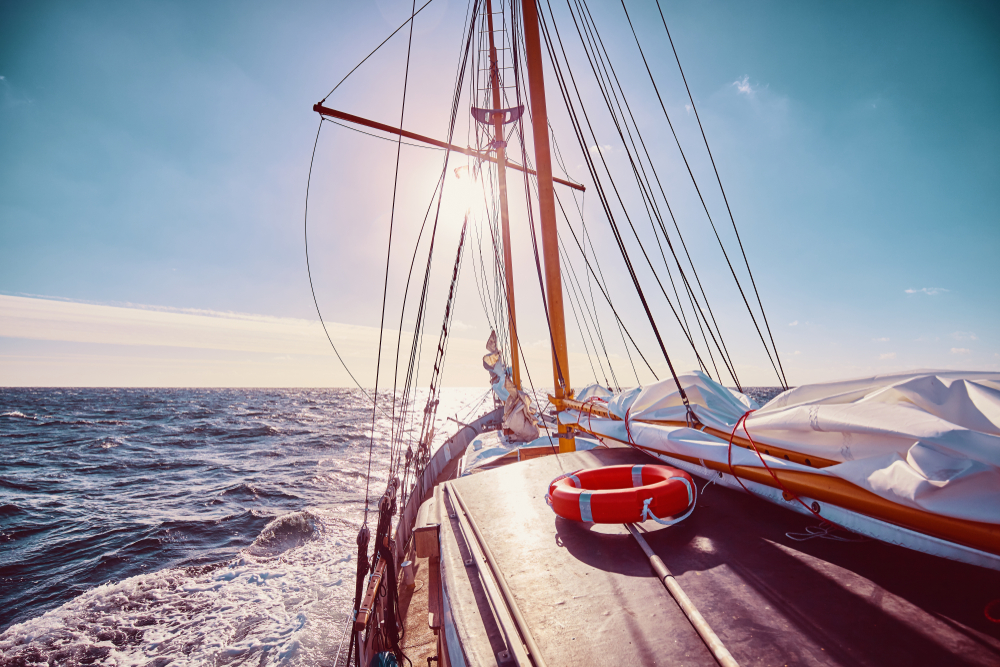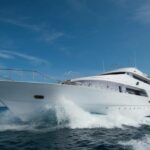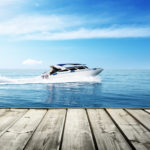You do not need a sailing licence to drive boats with sails at sea that are defined as “sailing boats”.
Sailing licence: recreational sailing on a sailing boat
If you are steering your own sailing dinghy along the beach, your 10- or 15-metre sailing boat along the coast in France, or your recreational sailing boat that’s over 25 metres in the waters of faraway countries, a recreational sailing licence is not considered necessary. In fact a sailing licence is not required if your boat is one that is powered mainly by its sail, as any engine is then considered to be auxiliary propulsion.
Sailing licence: recreational sailing on a sailing boat equipped with an engine
A sailing boat licence or recreational boating licence is mandatory for boats with an engine of more than 4.5 kW (6 hp), as the size (length) of the boat is only relevant in certain situations.
In these circumstances, the sailing licence is used for driving sailing boats at sea or on inland waters (lakes, rivers and canals) with a specific option (or extension) for each one. This licence is also useful for driving a personal watercraft (PWC) such as a Jet Ski.
Recreational boating licence, coastal option (coastal licence)
A candidate who has a sailing licence for inland waterways (river licence) is exempt from the technical part of this examination.
- Passage plan: limited to 6 nautical miles from a shelter.
- Engine power greater than 4.5 kW (6 hp).
- Each candidate must be at least 16 years old.
The training must be carried out on a training boat where the candidate’s “practical skills” are assessed at the helm for about 2 hours during a lesson that lasts for about three and a half hours in total. This exam cannot be taken as an external candidate.
The theoretical training takes about 5 hours. It is managed by a trainer and the candidate’s skills are validated by an MCQ with 30 questions.
Please note that the practical training can start before the end of the theoretical training.
Recreational boating licence, high sea option (high sea licence)
This licence being issued grants permission to sail with a recreational sailing boat on the waters of all seas and oceans. There are no distance limits that a recreational sailor must respect from a coastal shelter or similar, nor are they limited in the choice of their sailing boat engine power.
- Passage plan: sea, high sea, lakes, rivers, ponds (closed water bodies).
- Boats concerned: engine power greater than 4.5 kilowatts, regardless of size (length).
The training is validated by a single theoretical navigation test with a specific chart lasting 1 hour 30. This chart is a “set” chart published in 1991 with the number 9999. The exam must confirm, among other things, that the candidate
- can read and use a nautical chart,
- can calculate drifts due to currents or winds,
- can calculate the true heading,
- has knowledge of “electronic navigation aids”,
- uses the twelfths rule to calculate the tide in relation to their main port,
- fully knows the mandatory safety equipment beyond the 6 mile limit.
Passing the exam triggers the recreational sailing licence, high sea option.
Recreational sailing licence, yachting extension inland waters
The examination for the yachting licence, also known as the “river yachting extension licence”, is open to candidates over the age of 18 who have the sailing licence for inland waters.
- Passage plan: lakes, rivers, canals.
- Boats concerned: recreational boats with engine power of more than 4.5 kilowatts and a length of 20 metres or more.
The training lasts about 9 hours with specific objectives such as: protecting your boat (fires and waterways), ensuring passenger safety, knowing how to manage your boat (maintenance, usual breakdowns), leaving the dock and berthing in all weather conditions, etc.
The candidate’s skills are validated by the trainer as the training progresses, which can take place on a private boat or a training boat. The sailing licence with the yachting extension inland waters validates the skills of the candidate.
Recreational boat licence, inland waters option or river licence
A candidate who has a sailing licence with coastal option is exempt from the technical part of this examination.
- Passage plan: lakes, rivers, canals.
- Boats concerned: recreational boats with engine power of more than 4.5 kilowatts and a length of less than 20 metres, as well as PWC and sailing boats of less than 20 metres with an engine of more than 4.5 kW.
The theoretical training is validated by an MCQ with 30 questions, with a maximum of 5 errors allowed, and practical training is provided on a training boat. It lasts about 3 1⁄2 hours, including 2 hours at the helm.





